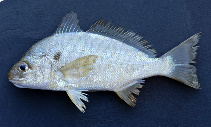http://www.fishbase.org/Summary/speciesSummary.php?genusname=Leiostomus&speciesname=xanthurus ---> http://52.67.158.155/Summary/speciesSummary.php?genusname=Leiostomus&speciesname=xanthurus
http://52.67.158.155/Summary/speciesSummary.php?genusname=Leiostomus&speciesname=xanthurus ---> https://fishbase.net.br/Summary/speciesSummary.php?genusname=Leiostomus&speciesname=xanthurus
https://fishbase.net.br/Summary/speciesSummary.php?genusname=Leiostomus&speciesname=xanthurus ---> https://fishbase.net.br/summary/Leiostomus-xanthurus.html
Leiostomus xanthurus, Spot croaker : fisheries, bait

You can
sponsor
this page
Common name (e.g. trout)
Genus + Species (e.g. Gadus morhua)
-

-
About this page
-
Languages
-
User feedbacks
-
Citation
-
Uploads
-
Related species
-


 Spot croaker
Add your observation in
Fish Watcher
Upload your
photos
and
videos
Spot croaker
Add your observation in
Fish Watcher
Upload your
photos
and
videos
Pictures
|
Google image
 Leiostomus xanthurus
Leiostomus xanthurus
Picture by
NOAA\NMFS\Mississippi Laboratory
Teleostei (teleosts) >
Eupercaria/misc
(Various families in series Eupercaria) >
Sciaenidae
(Drums or croakers)
Etymology:
Leiostomus:
Greek, leios = smooth + Greek,stoma = mouth (Ref.
45335
)
.
More on author:
Lacepède
.
Environment: milieu / climate zone / depth range / distribution range
Ecology
Marine; brackish; demersal; oceanodromous (Ref.
51243
); depth range ? - 60 m (Ref.
10325
). Subtropical; 43°N - 19°N
Western Atlantic: Massachusetts to northern Mexico; absent in southern Florida.
Size / Weight / Age
Maturity: L
m
?
range ? - ? cm
Max length : 36.0 cm TL male/unsexed; (Ref.
7251
); common length : 25.0 cm TL male/unsexed; (Ref.
3702
); max. published weight: 450.00 g (Ref.
40637
); max. reported age: 4 years (Ref.
12193
)
Found usually over sandy or muddy bottoms in coastal waters to about 60 m depth. Occurs in nursery and feeding grounds in river estuaries during summer and fall. Juveniles often stay in the estuarine waters throughout the year. Feeds mainly on worms, small crustaceans and organic detritus. A small specimen of this species was caught in Tokyo Bay, Japan, probably brought in with the ballast water of a ship (Ref.
10325
).
Life cycle and mating behavior
Maturity
|
Reproduction
|
Spawning
|
Eggs
|
Fecundity
|
Larvae
Robins, C.R. and G.C. Ray
, 1986. A field guide to Atlantic coast fishes of North America. Houghton Mifflin Company, Boston, U.S.A. 354 p. (Ref.
7251
)
IUCN Red List Status (Ref.
130435
)
Least Concern (LC)
; Date assessed:
09 October 2019
CITES
Not Evaluated
Not Evaluated
Threat to humans
Harmless
Human uses
Fisheries: commercial; bait: occasionally
FAO - Fisheries:
landings
; Publication:
search
|
FishSource
|
Sea Around Us
More information
Countries
FAO areas
Ecosystems
Occurrences
Introductions
Stocks
Ecology
Diet
Food items
Food consumption
Ration
Common names
Synonyms
Metabolism
Predators
Ecotoxicology
Reproduction
Maturity
Spawning
Spawning aggregation
Fecundity
Eggs
Egg development
Age/Size
Growth
Length-weight
Length-length
Length-frequencies
Morphometrics
Morphology
Larvae
Larval dynamics
Recruitment
Abundance
BRUVS
References
Aquaculture
Aquaculture profile
Strains
Genetics
Electrophoreses
Heritability
Diseases
Processing
Nutrients
Mass conversion
Collaborators
Pictures
Stamps, Coins Misc.
Sounds
Ciguatera
Speed
Swim. type
Gill area
Otoliths
Brains
Vision
Tools
E-book
|
Field guide
|
Identification keys
|
Length-frequency wizard
|
Life-history tool
|
Point map
|
Classification Tree
|
Catch-MSY
|
Special reports
Check for Aquarium maintenance
|
Check for Species Fact Sheets
|
Check for Aquaculture Fact Sheets
Download XML
Summary page
|
Point data
|
Common names
|
Photos
Internet sources
AFORO (otoliths)
|
Alien/Invasive Species database
|
Aquatic Commons
|
BHL
|
Cloffa
|
BOLDSystems
|
Websites from users
|
Check FishWatcher
|
CISTI
|
Catalog of Fishes
:
genus
,
species
|
DiscoverLife
|
ECOTOX
| FAO - Fisheries:
landings
; Publication:
search
|
Faunafri
| Fishipedia |
Fishtrace
| GenBank:
genome
,
nucleotide
|
GloBI
|
GoMexSI
(interaction data)
|
Google Books
|
Google Scholar
|
Google
|
IGFA World Record
|
MitoFish
|
OceanAdapt
|
Otolith Atlas of Taiwan Fishes
|
Public aquariums
|
PubMed
| Reef Life Survey | Socotra Atlas |
Tree of Life
| Wikipedia:
Go
,
Search
| World Records Freshwater Fishing |
Zoobank
|
Zoological Record
Estimates based on models
Preferred temperature (Ref.
123201
): 13.2 - 26.7, mean 24 °C (based on 314 cells).
Phylogenetic diversity index (Ref.
82804
): PD
50
= 1.0000 [Uniqueness, from 0.5 = low to 2.0 = high].
Bayesian length-weight: a=0.00912 (0.00583 - 0.01426), b=3.10 (2.97 - 3.23), in cm total length, based on LWR estimates for this species & (Sub)family-body (Ref.
93245
).
Trophic level (Ref.
69278
): 3.2 ±0.1 se; based on diet studies.
Generation time: 2.6 ( na - na) years. Estimated as median ln(3)/K based on 2
growth studies.
Resilience (Ref.
120179
): High, minimum population doubling time less than 15 months (K=0.4; tmax=4).
Fishing Vulnerability (Ref.
59153
): Low to moderate vulnerability (29 of 100).
Climate Vulnerability (Ref.
125649
): Moderate to high vulnerability (47 of 100).
Price category (Ref.
80766
):
Low
.
Nutrients (Ref.
124155
): Calcium = 101 [57, 196] mg/100g; Iron = 1.09 [0.59, 1.91] mg/100g; Protein = 19.6 [18.6, 20.7] %; Omega3 = 0.351 [0.207, 0.560] g/100g; Selenium = 23.2 [12.9, 43.0] μg/100g; VitaminA = 11.7 [4.5, 36.0] μg/100g; Zinc = 0.981 [0.723, 1.462] mg/100g (wet weight);
Back to Search
Random Species
Back to Top
Accessed through:
Not available
FishBase mirror site :
Laguna, Philippines
Page last modified by :
mrius-barile
|